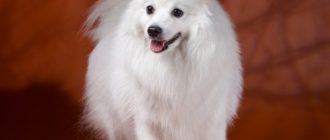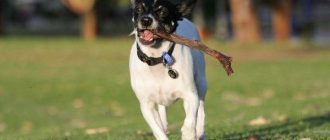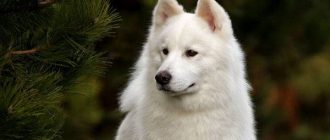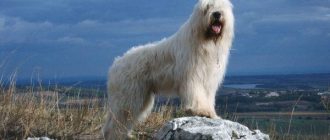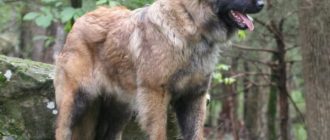Assessment of breed characteristics
Contents
| Adaptability Definition of how easy a dog is. can adapt to changes in life. |  |
| Shedding Level Level and frequency of hair loss in animal. |  |
| Level of tenderness Level and amount of tenderness and affection that the dog gives back in return for attention to itself. |  |
| Need for Exercise Daily Activity Level dogs. |  |
| Social need Required number of dog contacts with other animals as well as people. |  |
| Housing ratio Factor that determines the level of noise and other inconvenience that the dog can deliver to the owners in the ratio the size of the apartment to the size of the dog. |  |
| Grooming Number of bathing, combing, as well as necessary number of professional grooming sessions required the dog. |  |
| Friendliness in an unfamiliar environment society with strangers or in an unfamiliar environment. |  |
| The tendency to bark The tendency to bark and its frequency and volume. |  |
| Health Issues Potential Health Status dogs. |  |
| Territorial tendency of the dog to protect his house, yard or even a car owner. |  |
| Cat friendliness A trend towards cat tolerance and reduced manifestation of hunting instincts. |  |
| Intelligence Dog’s ability to think and solve emerging difficulties (not to be confused with learning!). |  |
| Education and training Level of difficulty in training a dog perform certain actions. |  |
| Friendliness for children Factor determining how much the dog friendly to children, whether she likes to play with them and endure some children’s pranks. |  |
| Game activity The concept is determined by its very name, and, usually found in almost all dogs. |  |
| Observability Dog’s ability to detect presence a stranger in his territory. |  |
| Friendliness for other dogs Dog’s tendency to find common language with other relatives. |  |
Brief description of the breed
Chihuahua is a small but rather sassy dog, distinguished by its individuality and perseverance. She always He knows what he wants and does everything to achieve what he wants. Despite small in size, a chihuahua can be an unrivaled watchman, and all thanks to the voiced barking.
Breed advantages
- Very attached to the owner;
- Ideal friend for adults and children;
- Cheerful and friendly;
- Easy to care for;
- Content is inexpensive.
Cons of breed
- Likes to dominate;
- Bullied with other dogs;
- It happens that barks a lot;
- Tries to protect and jealous of the owner;
- Needs frequent walks;
- Cable likes to mark territory.
It should be noted that a chihuahua is a dog that actually burst into show business. Many pop stars began to appear in front of cameras with this miniature dog. Besides the stars, the owners of this breed are many politicians and oligarchs, the pet has become an integral attribute of social events held people. It was from this that the peak of the popularity of Chihuahuas began. Such her popularity is highly justified, because the animal is very attached to to his master, and his piercing, sometimes funny eyes can brightly show the feelings and emotions of the dog. Despite the myriad positive qualities that a chihuahua possesses, do not think that this cute dog is suitable for families with children. Indeed, with she can live even in a small apartment, walk, without much hassle to travel, but here is the content in the house where there are small children – This is a moot point. The fact is that the Chihuahua is quite fragile and vulnerable dog, this is the key to the problem! During games children can injure, discomfort and inconvenience, and this causes stress, sometimes even serious fear. Moreover, if the Chihuahua is stressed or feels fear, that is, the risk that the animal will defend itself and may even bite a baby! Chihuahua, like most others dogs, does not accept aggression in relation to itself. Dog need correct, consistent training and control over behavior. This will prevent the possibility of aggressive pet behavior, which sometimes appears in dogs of this breed. Most dogs do not appreciate their actual size, Chihuahuas are no exception. it may cause her to come into conflict with the animal larger, which will naturally result in personal injury. a characteristic feature of these little dogs is the feeling property. Chihuahua values its own space, therefore the pet can defend itself quite aggressively from any encroachment on personal territory. In addition, dogs of this breed they don’t like strangers, and indeed it’s necessary to say that in most cases, a Chihuahua is attached to only one person. are divided into two groups: long-haired and short-haired. Wherein short-haired dogs tend to molt profusely, but long-haired require more careful leaving, consisting in combing frequently. Otherwise the long coat will start get confused, and the appearance of the animal will not be very attractive.
Appearance
- Body structure. Despite its small size, chihuahua is a pretty strong dog with a tight, compact body structure. The length of the body is slightly greater than the height at the withers. At males torso, as a rule, is almost square, and in females it can to be slightly elongated.
- Head. Characteristic head with noticeably rounded skull, which is a distinctive feature of the breed.
- Foot. The foot is clearly marked, full.
- Muzzle. The muzzle is small, broad at the base and slightly tapers to a dark nose, slightly upturned.
- Lips and bite. Lips are dry, closed, bite scissor or straight. A noticeable snack or overshot is considered flaw.
- Eyes. The eyes are large, round, very expressive, dark, not bulging.
- The ears. Big, erect ears, as if a little too big for such a small head, they give the dog an expression constant interest. At the base of the ears are wide, slightly taper to the tips, while resting slightly deviate to the side at an angle of 45o.
- Neck. Slightly curved, slightly elongated neck smoothly connects to a dense and strong body. In long-haired breeds the neck is framed by wool, which is very desirable.
- Back. The back is short, strong and straight, the withers slightly stands out.
- Rib cage. The chest is deep and wide, comes to the elbows, the ribs are correctly rounded. Bottom line emphasized by a noticeably fit belly.
- Tail. The tail is set high, when raised high bent a little in the form of a semicircle, the tip of the tail looks down. In tail rest time down. Never gotta hang between the back paws or twist below the ridge line. Tail coat long-haired breed resembles a feather.
- Limbs. Posture of the forelimbs straight, at the sight of side – the limbs are perpendicular to the body. Shoulder well straightened, elbows fit. The hind limbs are strong, perpendicular to the body parallel, straightened at the level of the ankle, hip and knee joints. Paws are very small, oval, fingers apart, claws strongly bent and moderately long. Paw pads well developed and very resilient.
Photo Chihuahua:
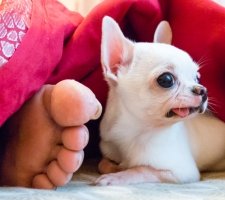



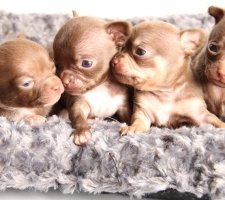

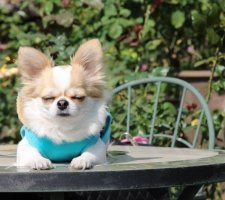

 Photo of Chihuahua dogs |
Photo of Chihuahua dogs |
Origin history
Different sources contain completely different information about the origin of this breed, and all because they rely more to retelling legends than facts. However, with full confidence we can say that the history of the Chihuahua breed is quite long. The ancestor of the Chihuahua was probably a little leaky dog, which existed during the Toltecs, who lived in Mexico in the 9th century. When they were defeated by the Aztecs, among the members of the tribe, their the winner, there was not much interest in these dogs, besides they did not find any use for them. Fortunately these little doggies very quickly became mascots for the Aztec princesses. It was believed that they accompanied the dead souls and were their guides in the afterlife, so they often became victims of the then funeral rites. A large number of small bones found during excavations of the graves of that period, only confirm this. In the ruins of the last palace ruler of the Aztecs – Montezuma, who died in 1520, American archaeologists have found clay and stone figures, as well as drawings on which depict small dogs with large ears, long claws and the characteristic chihuahua bald little temechok. Mexicans convinced that the modern chihuahua dog arose as a result of cross breeding “leaky” Toltecs and a bald dog, originally from Of Asia. Franciscan Bernardino de Sahagun born under the name Bernardino de Ribera lived between the 15th and 16th centuries. In their in numerous works he described the life of the Aztecs and also referred to the existence of two types of these dogs. The first type he described as a small dog with a yellow color, but the second – like a bald dog. Oddly enough, but in the US there is still among the offspring of Chihuahua Hairless dogs periodically appear. Mexican dog handlers argue that this is a confirmation of her theory Origin. In our time, there are both shorthair and long-haired breed of chihuahua. There is no consensus on which of these breeds was primary. Some argue that initially the dog was short-haired and only thanks to the Americans crossing it with a papillon and an American Spitz, appeared long-haired breed. Opponents of this theory argue that initially the dog was long-haired, and later it was crossed with English toy terrier, as a result of which arose short-haired breed. Until the mid-19th century, the Chihuahua was not known outside of Mexico. Once tourists visited this country, were fascinated by this little dog, acquired it and exported abroad. In the 20s of the last century, she got into America, where she got a lot of fans. Though Mexico is considered the birthplace of a chihuahua, it was the Americans who brought the breed dogs with declared genetic traits. For the first time this breed was presented at the exhibition in 1884, and in 1904 – first breed representative in American book registered animals. In the same year, about 5 were presented at the exhibition dogs of this breed, and already in 1916 their number grew to fifty. In 1923, American dog breeders founded the first club of the breed and finally decided to leave her the original name – Chihuahua. Single representatives of this breed appeared in England, approximately, in 1860, however, their undoubted appearance on the islands dates back to 1952 when the official the existence of a british chihuahua fan club and registered the first eight dogs. The British were so fascinated by her that by 1969 in England there were registered more than four thousand representatives of this breed. IN 1965, the chihuahua was divided into shorthair and long-haired, however their crossing is allowed. shorthair dogs in America were very successful so it was believed that they live longer. Fashion for long-haired dogs appeared much later, thanks to their attractiveness, they there were a lot of fans, not only in America, but throughout Europe. In Russia, a chihuahua appeared in the 90s of the last century, and at first there wasn’t much interest in her, but in recent years she became more and more popular.
Chihuahua character
It is difficult to find a dog whose character is more suited to saying: “in a weak body is a strong spirit.” In this little creating a locked character and courage of a big dog. Chihuahua is very self-confident if they don’t like something they can Resist an opponent of any size. As a rule, from such situations they come out of the water due to surprise and the ridiculousness of the situation. Looking at which aggressiveness they can attack someone several times more, it’s hard to believe that this four-legged creature knows about its small size. The owner of such a dog needs to be attentive and avoid such situations, because the enemy can be not very patient. This trait leads to obligatory strict training, education and training chihuahua. You need to teach your puppy to interact with others early. dogs and in time to stop the possible manifestations of aggression. You can not neglect this, otherwise you will not have time to look back, as a small aggressor will grow near you. It’s overbearing enough a dog whose character shows a marked desire dominance, so for every team she will try to you reply. Can pretend that he does not hear and does not understand, and if the owner will allow himself a moment of weakness and decide that the team can and not to fulfill, she will definitely remember this moment. The error that Chihuahua owners most often admit, this permission to do everything anything. This doggie needs training and, with inept upbringing, can behave cocky and noisy. Very independent breed with the makings of a little tyrant, but, fortunately, unusual intelligent and capable of learning, it can be easily re-educated into a well-mannered, polite and sweet dog. If you have problems with education, it is usually more associated with the wrong owner approach. Chihuahuas are not sissies, they are inherent strong enough character, therefore, you need to treat them like any other big dog, not like a mascot. Many owners they don’t understand that this dog, like other dog breeds, can and loves to run independently, so you should not always wear her in a bag, depriving the joys of a normal, active life. must establish certain rules and very gently but decisively train your dog to respect these rules. Disadvantages arise due to improper upbringing or its absence at all. Chihuahua is very attentive and curious, besides very active and show masterful traits of character, therefore always try to defend your opinion. At the same time, they are very attached to their owner and will do whatever it takes if he takes a little time and correctly express their expectations. And the efforts and good results in training must always be accompanied by praise and reward.
Maintenance and care
Chihuahua hair care is very simple due to the fact that dogs This breed has short hair. Normal combing will help reduce the amount of wool that can appear on furniture or carpets. Despite this, you should be aware that chihuahuas molt round year, this process is especially active during times of the year. During this period, more frequent and more thorough combing wool. These dogs are usually bathed a couple of times per month. Chihuahua dogs are prone to discharge from the eyes. therefore eyes also require special care, consisting in a systematic wiping with special wipes. Inspect your ears weekly pet. They should not show any signs of infection or inflammation. If you smell bad from your ears, or any unnatural discharge, you must immediately contact to the vet. He will prescribe appropriate procedures and treatment. Also Chihuahuas often have problems with their teeth. Weekly cleaning help to avoid problems with the oral cavity. Brushing your teeth start from an early age. So the pet will quickly get used to this procedure.
Training and training
The simplicity or complexity of training and training a chihuahua depends on the dog itself and its pedigree. Sometimes the learning process takes place easy and effortless, but in other cases this process complicated, for example, by a bold or, conversely, shy character animal. The temperament of the dog is determined exclusively on genetic level. It can not be re-educated. If the puppy’s parents calm, then he will be balanced and calm. from the temperament of the dog, the training process must have systematic. From the person who teaches chihuahua, Patience and perseverance are required. In the learning process, you can’t resort to aggression, chihuahua doesn’t like that! No small problem for many owners of these interesting dogs is training to the toilet. The fact is that the Chihuahua hates wet weather, therefore, during rain or other bad weather the pet can need a house. Be patient and you will certainly succeed train your pet.
Health and Disease
Despite its small size and apparent fragility, a chihuahua refers to fairly hardy dogs with good health. At appropriate feeding and care, the average period of life may be about 14 years old, and sometimes even more. But, owners should take preventative measures to maintain the health of your pets. Eye diseases such as like retinal atrophy, as well as those characteristic of miniature dogs diseases such as tracheal collapse, dislocation of the patella, aseptic inflammation of the femoral head, as well as disease hearts. There are also cases of hypoglycemia, that is, a decrease blood sugar levels. Symptoms are increased apathy. drowsiness, pallor of the mucous membranes, in rare cases even fainting. If any of the symptoms occur, give a solution of sugar or glucose for the animal. With proper and regular hygiene procedures can be prevented the occurrence of some of the diseases. First of all it concerns teeth. If the dog constantly receives soft, mushy food, stone very soon appears on the teeth, thanks to which in pathogenic bacteria multiply in the oral cavity. To To avoid this problem, Chihuahua teeth should be regularly clean. Conclusion from all of the above, we can say that dry food is the best food, because leftover food after it do not form a precipitate. Chihuahua prefers to eat quite in an unusual way. Instead of just eating from a bowl, they they take 2-3 granules in their teeth, carry them to their favorite place and they eat them in turn. They tend to be full, therefore you can not overfeed them, with their fragile body structure, excess weight can lead to joint problems. Experienced dog handlers argue that for this dog it’s better to sprinkle the entire daily portion feed the bowl immediately and let her eat it when she herself decides to do it. In this case, the dog will eat it gradually, not completely sweeping away the worry that then someone will take her food. As a result, this leads to the fact that the pet eats exactly as much as he needs and no more. Chihuahua Often there are problems with offspring, few puppies are born, and childbirth sometimes difficult and often everything ends with cesarean section. Serious health problems can occur in dogs too small in size. Dogs of this breed cannot be dwarf. Adult representatives of this breed whose weight is not exceeds more than 500 grams, are more prone to the emergence of various diseases, even seemingly frivolous infections or intestinal disorders can be a threat to them of life. Representatives of this breed often have a temporal fontanel for a long time. not delayed, for representatives of a very small size it may mean that he has little chance of long-term survival.

